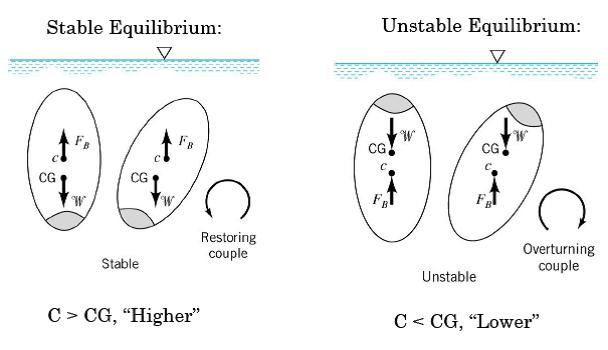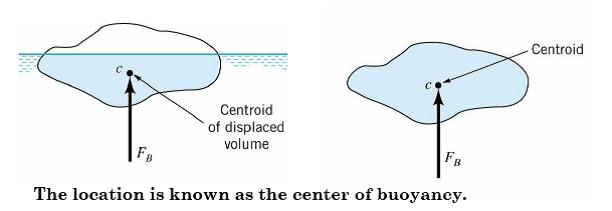Site pages
Current course
Participants
General
MODULE 1. FLUIDS MECHANICS
MODULE 2. PROPERTIES OF FLUIDS
MODULE 3. PRESSURE AND ITS MEASUREMENT
MODULE 4. PASCAL’S LAW
MODULE 5. PRESSURE FORCES ON PLANE AND CURVED SUR...
MODULE 6.
MODULE 7. BUOYANCY, METACENTRE AND METACENTRIC HEI...
MODULE 8. KINEMATICS OF FLUID FLOW
MODULE 9: CIRCULATION AND VORTICITY
MODULE 10.
MODULE 11.
MODULE 12, 13. FLUID DYNAMICS
MODULE 14.
MODULE 15. LAMINAR AND TURBULENT FLOW IN PIPES
MODULE 16. GENERAL EQUATION FOR HEAD LOSS-DARCY EQ...
MODULE 17.
MODULE 18. MAJOR AND MINOR HYDRAULIC LOSSES THROUG...
MODULE 19.
MODULE 20.
MODULE 21. DIMENSIONAL ANALYSIS AND SIMILITUDE
MODULE 22. INTRODUCTION TO FLUID MACHINERY
LESSON 11. ARCHIMEDES' PRINCIPLE
ARCHIMEDES’ PRINCIPLE
- Archimedes’ Principle states that the buoyant force has a magnitude equal to the weight of the fluid displaced by the body and is directed vertically upword.
- Buoyant force is a force that results from a floating or submerged body in a fluid.
- The force results from different pressures on the top and bottom of the object

W is the weight of the shaded area
F1 and F2 are the forces on the plane surfaces
FB is the buoyant force the body exerts on the fluid
The force of the fluid on the body is opposite, or vertically upward and is known as the Buoyant Force.
The force is equal to the weight of the fluid it displaces.
The buoyant forces acts through the centroid of the displaced volume
Stable Equilibrium: if when displaced returns to equilibrium position.
Unstable Equilibrium: if when displaced it returns to a new equilibrium position.

STABILITY: SUBMERGEDOBJECT
-
If the Centre of Gravity is below the centre of buoyancy this will be a righting moment and the body will tend to return to its equilibrium position(Stable).
-
If the Centre of Gravity is above the centre of buoyancy, an over turning moment is produced and the body is unstable.
-
Note that, As the body is totally submerged, the shape of displaced fluid is not altered when the body is tilted and so the centre of buoyancy unchanged relative to the body.
